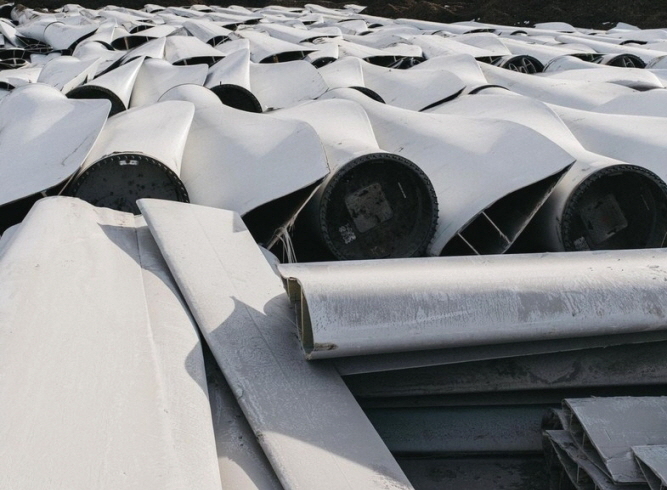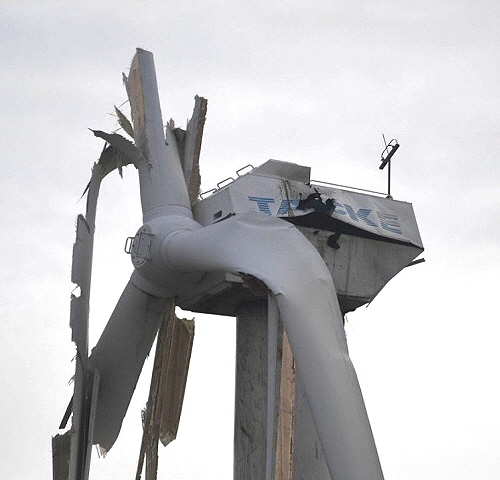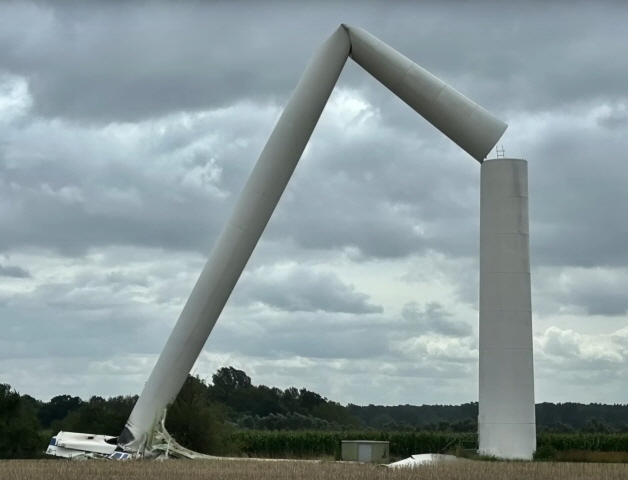

Index Home Desert-Electricity World Deserts Electric Network Types of Produktion Comparison Water Network Hydrogen New Industry Green Cities Energy Transition Imprint
Wind Power
Wind energy use
Conclusion:
Wind turbines & Co. cost a lot, take up a lot of space, produce little power, but a lot of waste that is difficult to dispose of. Even with the most modern art, only the tiny generator and the gearbox can be recycled. The concrete base, the column and the wings are and remain hazardous waste. A wind turbine only lasts a maximum of 25 years. Given the gigantic expansion plans, this means an irresponsible amount of waste.
Wind power is unreliable! Without wind there is no energy.
Offshore and onshore systems change the climate and cause lasting damage to nature.
For comparison: A solar power plant in the desert produces a lot of power every day, takes up 90% less space and is located in regions where it cannot cause damage. It lasts over 100 years and can be recycled up to 90%.
Wind power must therefore be limited to a minimum, while solar power plants in the world's deserts must be expanded.
Problems of wind energy in detail
The human use of wind energy is an intervention in the ecosystem. Energy cannot be created, only converted. All natural energy is used 100 percent by nature without human intervention; any intervention disrupts the original energetic balance. Wind turbines in particular are disruptive in many ways.
Wind turbines are fog machines
Wind turbines create wake turbulence that persists for kilometers. Systems standing in water, in particular, raise the moist ground air and mix it with the colder upper layer of air, causing the water to condense into fine droplets, which then combine as a whole to form real clouds. The opposite effect occurs at night, only much stronger, when the cold, moist air sinks to the ground and the warmer layers settle on top. The suction force of the wind turbines draws the cold, damp air from the ground and mixes it with the warm air layers above; there is a uniform temperature and the important morning dew on the ground is eliminated. Over time, the soil around the systems dries out.
Furthermore, wind turbines significantly disrupt the natural movement of air. The air is slowed down by the wind turbines and the turbulence increases. This atmospheric disturbance then lasts from ten to a hundred kilometers and in large systems, especially in the planned extreme expansion, these also influence the large atmospheric currents, which leads to phenomena such as long-lasting dryness or even supra-regional droughts, as well as on the other hand heavy rain events. On land, evaporating soil moisture is drawn from the ground, transported upwards, and thus the entire surrounding area is deprived of water. Water vapor is generated in the sea, which then moves around uncontrollably in large cloud fields and can suddenly fall somewhere. If electromobility were to actually become established and the industry were to switch completely to electrical energy and hydrogen, the demand for electricity would increase enormously and if we were to cover all of this mainly with wind turbines, the land consumption would be simply gigantic and the associated increase in temperature and weather turbulence would also be very high.


Wind turbines destroy forests
Large-scale expansion of wind turbines is currently underway in Norway and Sweden. I am sure that the natural habitat with reindeer and the flowering forest areas that has existed there for thousands of years will be significantly disturbed and thus destroyed. The forest areas will dry out and stop the natural growth of the forest. Wind turbines undoubtedly have a particularly damaging impact in forests. First, the forest is decimated by the felling as a CO2 sink and water reservoir. Erosion and leaching of the former forest floor as well as silting lead to faster water runoff, and the cleared areas are threatened with desertification. In addition, there is the underground soil sealing by the reinforced concrete foundations, which weigh several thousand tons and are more than three meters thick. The moist soil above dries out and the water cannot seep away and participate in groundwater formation. The same effect occurs on the compacted access roads and assembly areas. The overall climate-regulating effect of the forest is reduced and the natural resistance to extreme weather is reduced. It is obvious that the area of the driest soils roughly coincides with the spatial distribution of wind turbines.
Wind turbines are heaters
How does a wind turbine actually work? Well, from a physical point of view, the wind blows along the wing, creating excess pressure on one side and negative pressure on the opposite side. This causes the wing to move in one direction and, when a generator is coupled to the axle to which the wings are attached, performs work. However, this doesn't work as smoothly as it always sounds in the wonderful descriptions: "Wind in, electrical energy out". What happens is exactly what happens with an ice skate blade on the ice. This creates pressure and friction and thus heat, which causes the ice to melt and creates a film of water on which you can slide.
With a wind turbine, pressure and friction also arise when the wind overcomes the resistance of the blade and the wind turbine does its work. As a result, the air behind the wind turbine warms up by approx. 0.2°C, depending on the prevailing conditions. Part of the converted energy is also immediately released into the environment via heat loss from generators, gearboxes and transformer stations. In extensive American studies: "Climatic impacts of wind power", Lee Miller and David Keith from Harvard University researched the effects of onshore wind farms in the USA in 2018 and came to the conclusion that with the current electricity coverage in the USA with wind power the Temperature over the continental United States would rise by up to 2.4°C.
Overall, of course, this doesn't mean anything good. If every country wanted to cover the current plus the expected energy needs through electromobility and industry with wind power, we would easily end up in dangerous warming scenarios of up to +2°C, meaning that we would gain nothing but absolutely nothing. We would neither limit global warming nor the expected weather turbulence but would encourage them. Actually, we should only use this form of energy generation where absolutely necessary. We have to act very carefully here so as not to repeat the same mistakes that got us into this bad situation.
A lot of space required, high resource consumption, little energy
Wind farms only have a tenth of the energy density of solar thermal systems and only for a very limited time. This means that wind farms require 90% more space than a solar thermal system to generate the same amount of energy. The resource consumption is also 90% greater:
Wind turbines contain vast amounts of copper and rare earths. Up to 25 tons of copper and up to 3 tons of rare earths are contained in one wind turbine. A medium-sized wind turbine plant, including infrastructure, requires up to 400 tons of copper and 45 tons of rare earth metals such as praseodymium, dysprosium, terbium or neodymium. A wind turbine with a power of ten megawatts requires 2 tons of neodymium alone. In addition to GRP, balsa wood is also used in the newer rotor blades, so there are around 50 trees in one rotor blade. For an entire wind turbine, around 150 trees are needed. The housing of the machine house is made of aluminium, of which up to 350 tons are needed per wind turbine.
Without these raw materials, the so-called energy transition will fail. With this extreme consumption and the expanded plans, copper and rare earths in particular will become scarce.
This is precisely why recycling, especially that of of rare earths, is extremely important. But once the plants are in place, it is very difficult, for example, to dig the cables out of the ground every thirty years, to dismantle the entire infrastructure and recycle them. Metals are still only shredded and sorted, resulting in various material mixtures and not pure metals. No one has even thought about dismantling the motors and generators by hand and separating the material. The situation is even worse with rare earths, where laboratories are currently still busy with extremely trivial melting experiments, and there is nothing of this in industry. At best, the gold can be extracted from electronics, the rest burns in the furnace with high levels of pollutants. The balsa wood in the latest rotor blades cannot be reused.
Conclusion: Huge bases made of steel and concrete, huge steel or concrete columns, enormous rotors, huge amounts of copper, aluminium and rare earths and then so little energy. Like this cannot effective counteract the danger posed by this enormous warming of the earth's surface and failure is not an option. It can only be done together and only with the most effective form of energy production, and that is the generation of electrical energy using solar power plants in the deserts of the world.
Wind turbine waste and carbon dioxide
Not only do wind turbines leave behind a lot of waste that is difficult to dispose of, their production also produces huge amounts of carbon dioxide.
After 20-25 years, a wind turbine must be dismantled for safety reasons.
A 7 megawatt wind turbine is supposed to save around 6790 tons of CO2 in its lifetime. Is that true? Let's take a closer look.
Currently, around 600 kg of CO2 are produced per m³ of reinforced concrete. For a wind turbine base for a 7 MW turbine, around 1680 cubic meters of concrete and 200 tons of steel are needed, i.e. 1008 tons of CO2. Just over 200 truckloads of concrete are transported in a whole day from a factory 50 - 100 km away. This costs also CO2. Just under 1 kg per km is an average of around another 22 tons more. Now we are already at 1030 tons of CO2. As I said, just for the base. Let's take a look at the steel column, around 150 - 250 meters high, 20-30 m in diameter, steel thickness up to 1m, weight 120 - 200 tons of steel, smelted, rolled, wound, welded in segments. Or with the hybrid tower, one half is made of reinforced concrete tubes and only the rest is a steel tower. Here, around 1300-1600 cubic meters of concrete and 180-200 tons of steel are used. We can therefore safely assume that a wind turbine tower produces another 1000 - 2000 tons of CO2, depending on the design and height. The iron ore comes mainly from Brazil, by the way. In addition, there is transport by heavy oil transport ship from Brazil. So another at least 200 tons of CO2 and various toxins. The blades are made of carbon fiber reinforced composites (CFRP), carbon fibers glued together with highly toxic synthetic resin. After they end their life, they are shredded, mixed with fire helpers and burned in concrete plants. The cement industry is now to be obliged to use at least CO2 separation systems, but there will still be no cleaning of toxic substances. The aim is to recover the carbon fibers in the future, but so far it has only been lip service. There are no concrete test results yet. So for now, it will stay that way: If three powerful CFRP blades are used, another 100-300 tons of CO2 are produced over the life of the system, during production and destruction. The nacelle with the control motors for the blades, the powerful gearbox and the generator is not exactly a children's birthday party where everything is free. Here, too, another 100-300 tons of CO2 are produced. All in all, a wind turbine produces an average of 3130 tons of CO2, and this does not include dismantling the system (demolition) and disposal of the remains. Costs another 500-1000 tons of CO2. In addition, the construction of the infrastructure, construction at sea, the cables, the substations, and thus another 250-500 tonnes of CO2 are still missing. So we are now at the well-intentioned figure of around 4500 tonnes of CO2 that a large wind turbine produces in its lifetime, saving a total of 6790 tonnes of CO2, so the bottom line is a saving of unfortunately only 2290 tonnes of CO2.
However, the atmosphere will be enriched with a further 4,500 tonnes of CO2 and this will only end when the industry is completely converted and recycling is finally 100% possible. The problem is that for 10,000 large wind turbines, the atmosphere is charged with an additional 45 million tons of CO2, which then remains in the atmosphere for around 1,000 years. After 1000 years, around 15 to 40 percent of it is still left in the atmosphere. However, the entire mining process takes several hundred thousand years. We must therefore, NOT could or should, we must absolutely take the path with the lowest emissions and that is the production of thermosolar power plants where there is already emission-free energy and we must operate these plants for at least 100 years or longer.


The biggest problem is the wings
Fiberglass plastics (GRP) cannot be stored in landfills because they do not rot. You can't burn them either because they barely burn. They are therefore converted into a substitute fuel using combustion conveyors and then burned with other materials, which significantly reduces the value of the wind turbines as a green energy supplier. The smoke that arises from this process has to be cleaned in extremely complex systems and this process leaves highly toxic dust and an equally toxic liquid which then also has to be stored in hazardous waste landfills.




But the tons of concrete bases and columns of the concrete wind turbines also represent a heavy producer of CO2. The bases can no longer be used. They have to be shredded and are then only suitable as a secondary product in road construction.
The riot of wind turbines
Wind turbines are extremely loud, but most people don't even hear them. Wind turbines generate infrasound that can be measured and perceived at a distance of up to 100 km. According to TÃœV regulations, this noise should actually be banned.
Infrasound around 16-20 Hz can cause severe hearing damage, especially in children, because the eardrum is constantly moving in a large range, although you may not even notice this sound. So if you have been wondering about a tinnitus in recent years, you were wondering, think about the possibility that this may come from the wind turbines in the immediate vicinity (10 - 50 km) and is irreversible. Contrary to the existing claims that infrasound is only effective in the immediate area (approx. 100m), it has been sufficiently proven that infrasound can spread in a radius of up to 100 km (depending on the conditions). Because male lions use infrasound around their territories, it should be noted that numerous measurements were carried out here, all of which confirm the widespread spread of infrasound. Then it is the case that wind turbines do not all start at the same time, do not all run at the same speed and do not encounter the same wind conditions, which means that the beating frequencies and the starting points are different. Which results in a mixed frequency, a wavering hum, at a greater distance around which results in up to 30 Hz. Sensitive people can obviously perceive this sound and with a good measuring microphone and proper amplification it can be measured clearly. Many animals, including domestic cats, also hear these sounds.
All of these negative factors are increasingly coming together in the population to a: “We don’t want to have it” and they are absolutely right. Investing in such effort, producing so much waste, creating so many harmful effects and risking environmental damage just because you are not capable or unwilling to engage in real international cooperation is irresponsible.
With an international energy network based on solar power plants, all problems could be solved easily and cost-effectively.
Falling and burning giants or the risk of accidents of the Wind-wheels









Lightning strikes and overload-related fires, spark discussion about wind turbines in forest areas. Because such fires cannot be put out, or can only be put out with great difficulty. Entire forest areas can burn down if sparks ignite them. Wind turbines knocked over by the wind, fatigue kinks. With the storms expected in the near future, wind turbines are a dangerous matter. Who can blame local residents for defending themselves against these facilities in their area because of such images, which are by no means uncommon?
Other topics:
Index Home Desert-Electricity World Deserts Electric Network Types of Produktion Comparison Water Network Hydrogen New Industry Green Cities Energy Transition Imprint


